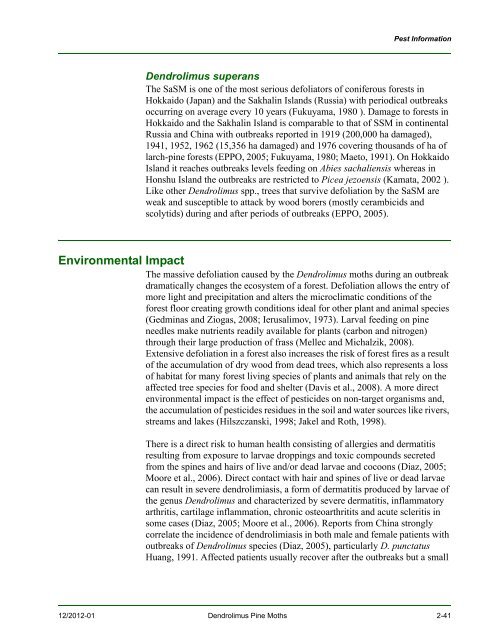New Pest Response Guidelines - aphis - US Department of Agriculture
New Pest Response Guidelines - aphis - US Department of Agriculture
New Pest Response Guidelines - aphis - US Department of Agriculture
Create successful ePaper yourself
Turn your PDF publications into a flip-book with our unique Google optimized e-Paper software.
<strong>Pest</strong> Information<br />
Dendrolimus superans<br />
The SaSM is one <strong>of</strong> the most serious defoliators <strong>of</strong> coniferous forests in<br />
Hokkaido (Japan) and the Sakhalin Islands (Russia) with periodical outbreaks<br />
occurring on average every 10 years (Fukuyama, 1980 ). Damage to forests in<br />
Hokkaido and the Sakhalin Island is comparable to that <strong>of</strong> SSM in continental<br />
Russia and China with outbreaks reported in 1919 (200,000 ha damaged),<br />
1941, 1952, 1962 (15,356 ha damaged) and 1976 covering thousands <strong>of</strong> ha <strong>of</strong><br />
larch-pine forests (EPPO, 2005; Fukuyama, 1980; Maeto, 1991). On Hokkaido<br />
Island it reaches outbreaks levels feeding on Abies sachaliensis whereas in<br />
Honshu Island the outbreaks are restricted to Picea jezoensis (Kamata, 2002 ).<br />
Like other Dendrolimus spp., trees that survive defoliation by the SaSM are<br />
weak and susceptible to attack by wood borers (mostly cerambicids and<br />
scolytids) during and after periods <strong>of</strong> outbreaks (EPPO, 2005).<br />
Environmental Impact<br />
The massive defoliation caused by the Dendrolimus moths during an outbreak<br />
dramatically changes the ecosystem <strong>of</strong> a forest. Defoliation allows the entry <strong>of</strong><br />
more light and precipitation and alters the microclimatic conditions <strong>of</strong> the<br />
forest floor creating growth conditions ideal for other plant and animal species<br />
(Gedminas and Ziogas, 2008; Ierusalimov, 1973). Larval feeding on pine<br />
needles make nutrients readily available for plants (carbon and nitrogen)<br />
through their large production <strong>of</strong> frass (Mellec and Michalzik, 2008).<br />
Extensive defoliation in a forest also increases the risk <strong>of</strong> forest fires as a result<br />
<strong>of</strong> the accumulation <strong>of</strong> dry wood from dead trees, which also represents a loss<br />
<strong>of</strong> habitat for many forest living species <strong>of</strong> plants and animals that rely on the<br />
affected tree species for food and shelter (Davis et al., 2008). A more direct<br />
environmental impact is the effect <strong>of</strong> pesticides on non-target organisms and,<br />
the accumulation <strong>of</strong> pesticides residues in the soil and water sources like rivers,<br />
streams and lakes (Hilszczanski, 1998; Jakel and Roth, 1998).<br />
There is a direct risk to human health consisting <strong>of</strong> allergies and dermatitis<br />
resulting from exposure to larvae droppings and toxic compounds secreted<br />
from the spines and hairs <strong>of</strong> live and/or dead larvae and cocoons (Diaz, 2005;<br />
Moore et al., 2006). Direct contact with hair and spines <strong>of</strong> live or dead larvae<br />
can result in severe dendrolimiasis, a form <strong>of</strong> dermatitis produced by larvae <strong>of</strong><br />
the genus Dendrolimus and characterized by severe dermatitis, inflammatory<br />
arthritis, cartilage inflammation, chronic osteoarthritits and acute scleritis in<br />
some cases (Diaz, 2005; Moore et al., 2006). Reports from China strongly<br />
correlate the incidence <strong>of</strong> dendrolimiasis in both male and female patients with<br />
outbreaks <strong>of</strong> Dendrolimus species (Diaz, 2005), particularly D. punctatus<br />
Huang, 1991. Affected patients usually recover after the outbreaks but a small<br />
12/2012-01 Dendrolimus Pine Moths 2-41

















